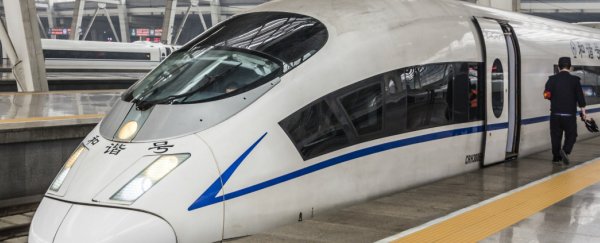China has announced that's it's developed new technology that will help its bullet trains reach an ultra-fast 500 km/h.
That isn't quite as fast as Japan's Maglev trains, which hit record-breaking speeds of 590 km/h earlier this year, but it's more than twice the top speed of most trains in the US, and more than three times that of Australia's rail network. And in a win for the local economy, the technology is all its own.
"Now we have our own permanent magnet synchronous traction system with full intellectual property rights, marking a new chapter in China's high-speed railways," Ding Rongjun, head of the Zhuzhou Institute in the country's Hunan province, where the technology was developed, told China Daily.
So what's a permanent magnet synchronous traction system? It's basically a motor that uses permanent magnets rather than a magnetic field created by windings of the rotor to propel the train forward. That means the new 690-kilowatt traction system has significantly fewer parts and is lighter and more efficient, allowing China's already-speedy bullet trains to go 50 percent faster.
But unlike the Maglev system, the train remains in contact with the track, and so is still subject to the effects of friction.
The new traction technology was developed by CRRC Corp, the country's largest train maker, and has been in development for close to 12 years, according to China Daily.
In 2011, the team installed a lower power 190-kilowatt version of the new traction system on trains running on Subway Line 2 in Shenyan, in the Liaoning province. As of May 2015, the equipment had operated without any malfunctions for 70,000 kilometres of train travel, Want China Times reports.
It started trialling the 690-kilowatt system - which Rongjun claims will be capable of 500 km/h - in selected bullet trains in October last year. If all goes to schedule, the system will soon enter mass production and will be rolled out across the country by 2018.
Today's bullet trains are mostly powered by alternating current asynchronous motors, a traction system that was developed back in the '70s. Jia Limin from Beijing Jiaotong University, and head of China's high-speed railway innovation program, told China Daily that the upgrade will reduce electrical configuration and could also reduce electrical consumption.
"The new system has fewer parts than the current traction apparatus, so it is more reliable and efficient," he explained.
We'll wait until the new train speeds are verified before we get too excited, but we're always fans of anything that makes train travel faster and more efficient. And while 500 km/h is a far cry from the 1,200 km/h top speed promised by Elon Musk's hypothetical hyperloop system, it would still take us from Los Angeles to San Francisco in just over an hour, which would be pretty damn cool. Bring it on!
